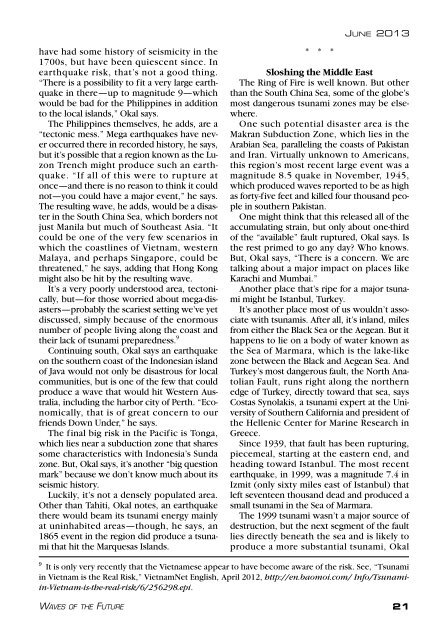Analog Science Fiction and Fact - June 2013
Analog Science Fiction and Fact - June 2013
Analog Science Fiction and Fact - June 2013
You also want an ePaper? Increase the reach of your titles
YUMPU automatically turns print PDFs into web optimized ePapers that Google loves.
have had some history of seismicity in the<br />
1700s, but have been quiescent since. In<br />
earthquake risk, that’s not a good thing.<br />
“There is a possibility to fit a very large earthquake<br />
in there—up to magnitude 9—which<br />
would be bad for the Philippines in addition<br />
to the local isl<strong>and</strong>s,” Okal says.<br />
The Philippines themselves, he adds, are a<br />
“tectonic mess.” Mega earthquakes have never<br />
occurred there in recorded history, he says,<br />
but it’s possible that a region known as the Luzon<br />
Trench might produce such an earthquake.<br />
“If all of this were to rupture at<br />
once—<strong>and</strong> there is no reason to think it could<br />
not—you could have a major event,” he says.<br />
The resulting wave, he adds, would be a disaster<br />
in the South China Sea, which borders not<br />
just Manila but much of Southeast Asia. “It<br />
could be one of the very few scenarios in<br />
which the coastlines of Vietnam, western<br />
Malaya, <strong>and</strong> perhaps Singapore, could be<br />
threatened,” he says, adding that Hong Kong<br />
might also be hit by the resulting wave.<br />
It’s a very poorly understood area, tectonically,<br />
but—for those worried about mega-disasters—probably<br />
the scariest setting we’ve yet<br />
discussed, simply because of the enormous<br />
number of people living along the coast <strong>and</strong><br />
their lack of tsunami preparedness. 9<br />
Continuing south, Okal says an earthquake<br />
on the southern coast of the Indonesian isl<strong>and</strong><br />
of Java would not only be disastrous for local<br />
communities, but is one of the few that could<br />
produce a wave that would hit Western Australia,<br />
including the harbor city of Perth. “Economically,<br />
that is of great concern to our<br />
friends Down Under,” he says.<br />
The final big risk in the Pacific is Tonga,<br />
which lies near a subduction zone that shares<br />
some characteristics with Indonesia’s Sunda<br />
zone. But, Okal says, it’s another “big question<br />
mark” because we don’t know much about its<br />
seismic history.<br />
Luckily, it’s not a densely populated area.<br />
Other than Tahiti, Okal notes, an earthquake<br />
there would beam its tsunami energy mainly<br />
at uninhabited areas—though, he says, an<br />
1865 event in the region did produce a tsunami<br />
that hit the Marquesas Isl<strong>and</strong>s.<br />
* * *<br />
JUNE <strong>2013</strong><br />
Sloshing the Middle East<br />
The Ring of Fire is well known. But other<br />
than the South China Sea, some of the globe’s<br />
most dangerous tsunami zones may be elsewhere.<br />
One such potential disaster area is the<br />
Makran Subduction Zone, which lies in the<br />
Arabian Sea, paralleling the coasts of Pakistan<br />
<strong>and</strong> Iran. Virtually unknown to Americans,<br />
this region’s most recent large event was a<br />
magnitude 8.5 quake in November, 1945,<br />
which produced waves reported to be as high<br />
as forty-five feet <strong>and</strong> killed four thous<strong>and</strong> people<br />
in southern Pakistan.<br />
One might think that this released all of the<br />
accumulating strain, but only about one-third<br />
of the “available” fault ruptured, Okal says. Is<br />
the rest primed to go any day? Who knows.<br />
But, Okal says, “There is a concern. We are<br />
talking about a major impact on places like<br />
Karachi <strong>and</strong> Mumbai.”<br />
Another place that’s ripe for a major tsunami<br />
might be Istanbul, Turkey.<br />
It’s another place most of us wouldn’t associate<br />
with tsunamis. After all, it’s inl<strong>and</strong>, miles<br />
from either the Black Sea or the Aegean. But it<br />
happens to lie on a body of water known as<br />
the Sea of Marmara, which is the lake-like<br />
zone between the Black <strong>and</strong> Aegean Sea. And<br />
Turkey’s most dangerous fault, the North Anatolian<br />
Fault, runs right along the northern<br />
edge of Turkey, directly toward that sea, says<br />
Costas Synolakis, a tsunami expert at the University<br />
of Southern California <strong>and</strong> president of<br />
the Hellenic Center for Marine Research in<br />
Greece.<br />
Since 1939, that fault has been rupturing,<br />
piecemeal, starting at the eastern end, <strong>and</strong><br />
heading toward Istanbul. The most recent<br />
earthquake, in 1999, was a magnitude 7.4 in<br />
Izmit (only sixty miles east of Istanbul) that<br />
left seventeen thous<strong>and</strong> dead <strong>and</strong> produced a<br />
small tsunami in the Sea of Marmara.<br />
The 1999 tsunami wasn’t a major source of<br />
destruction, but the next segment of the fault<br />
lies directly beneath the sea <strong>and</strong> is likely to<br />
produce a more substantial tsunami, Okal<br />
9 It is only very recently that the Vietnamese appear to have become aware of the risk. See, “Tsunami<br />
in Vietnam is the Real Risk,” VietnamNet English, April 2012, http://en.baomoi.com/ Info/Tsunamiin-Vietnam-is-the-real-risk/6/256298.epi.<br />
WAVES OF THE FUTURE<br />
21

















